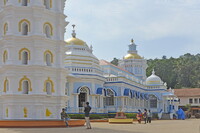| dc.coverage.spatial | Site: Ponda, Goa, India | en_US |
| dc.coverage.temporal | 1739 (creation) | en_US |
| dc.creator | unknown (Indian (South Asian)) | en_US |
| dc.date | 1739 | en_US |
| dc.date.accessioned | 2016-06-21T19:09:56Z | |
| dc.date.available | 2016-06-21T19:09:56Z | |
| dc.date.issued | 1739 | en_US |
| dc.identifier | 264563 | en_US |
| dc.identifier.other | archrefid: 3371 | en_US |
| dc.identifier.uri | http://hdl.handle.net/1721.3/180621 | |
| dc.description | Base of the lamp tower (deep stambha) and raking view of the main temple; The temple relocated to the present location during the Portuguese forced conversions in 1560. The current structure was built in 1739 during the reign of the Marathas. The main temple is dedicated to Bhagavan Manguesh, an incarnation of Shiva, worshipped here as Shiva linga. One feature that marks Goan Hindu temple style is the modification of the lat or stambha pillar into a "lamp tower" (deep stambha) that can be lit with traditional oil lamps (diya). The example at the Shri Mangueshi Temple is typical, as described by Jose Pereira: "a polygonal (octagonal) structure, with the corners of the polygons marked by engaged columns, the space between them being occupied by niches for lamps, and the whole crowned by an entablature surmounted by finials." These were influenced by Portuguese and Western architecture. Source: Wikipedia; http://en.wikipedia.org/wiki/Main_Page (accessed 8/25/2015) | en_US |
| dc.format.medium | stone; wood; stucco; paint; gold leaf | en_US |
| dc.rights | © Scott Gilchrist, Archivision, Inc. | en_US |
| dc.subject | architecture | en_US |
| dc.subject | deities | en_US |
| dc.subject | Hinduism | en_US |
| dc.subject | Shavism | en_US |
| dc.subject | Saivism | en_US |
| dc.subject | Eighteenth century | en_US |
| dc.subject | Indo-Portuguese | en_US |
| dc.title | Shri Mangueshi Temple | en_US |
| dc.title.alternative | Mangeshi Temple | en_US |
| dc.type | image | en_US |
| dc.rights.access | Licensed for educational and research use by the MIT community only | en_US |
| dc.identifier.vendorcode | 1A2-IN-G-SMT-A02 | en_US |
| vra.culturalContext | Indian (South Asian) | en_US |
| vra.technique | construction (assembling) | en_US |
| vra.worktype | lat (pillar) | en_US |
| vra.worktype | temple | en_US |
| dc.contributor.display | unknown (Indian (South Asian)) | en_US |

